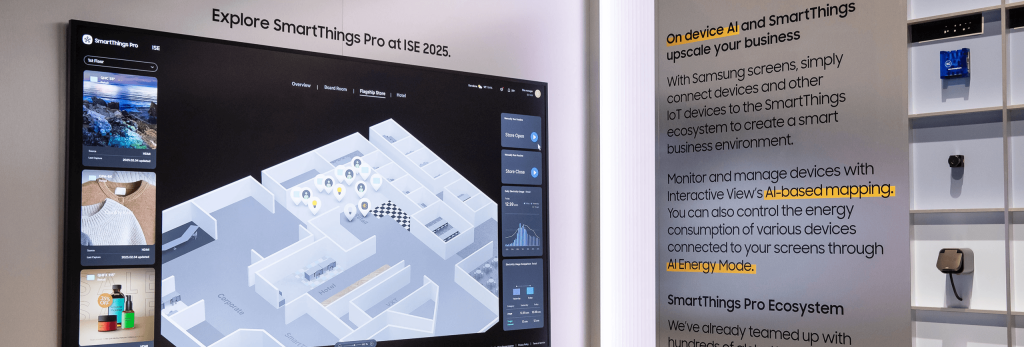Two technologies are leading the charge in digital signage comparison: LED screens & E-Paper displays. One grabs attention. The other delivers detail. While they’re often compared, the truth is they work better together. This article explores how combining LED screens & E-Paper displays creates a flexible, cost-effective solution that delivers impact and clarity without compromise.
Understanding the Technologies: E-Paper vs LED
LED displays are known for their brightness, colour, and movement. They’re designed to be seen. Whether it’s a video loop, flashing sale banner, or live update, the goal of LED screens is to get the message across.
That visibility comes with power. Literally. LED display features include high brightness and motion capabilities. However, they also consume more energy and need regular maintenance. But when you need something noticed, it’s very effective.
E-Paper displays, on the other hand, are more subtle. They look like printed paper, which makes them easier to read in daylight. No glare. No flicker. And the big win? E-Ink display benefits include ultra-low power usage. Once an image is shown, it stays there without drawing more power.
So in the E-Paper vs LED debate, it’s not about one being better. It’s about where and how you use each one. That’s the value of a hybrid system.
Why Hybrid Digital Signage Matters
There’s no one-size-fits-all solution when it comes to digital signage comparison.
With LED screens, you get high-impact messages. It’s perfect for flash sales, alerts, or promotions. E-Paper displays are better for carrying the longer-term content. Examples include schedules, pricing, or product information. In this case, an E-paper display is the better choice because it doesn’t need to change every few seconds.
This digital signage comparison matters because it affects power bills, maintenance costs, and how people interact with your brand. Hybrid signage helps businesses reduce energy usage while still delivering engaging content. It also gives staff more control over what gets updated and when.
And when you consider both LED display features and E-Ink display benefits, you get a system that works smarter, not harder.
Hybrid Use Case: Retail
Retail is one of the most exciting spaces for digital signage. And hybrid setups just make sense here. This pairing is a perfect digital signage comparison.
(1) LED for promotions
LED is great for bold, fast-moving content. A supermarket could use LED screens in the entryway or above aisles to promote daily deals or seasonal campaigns. It’s about drawing attention and driving action using clear LED display features that attract from a distance.
(2) E-Paper for product information
Meanwhile, on the shelves, E-Paper displays take care of the details. Digital price tags, stock availability, and specific product information. A tech store, for example, might use E-Paper next to devices to show specific information, while LED draws customers in with rotating visuals of new arrivals.
Hybrid Use Case: Transport
Transport hubs are hectic. People need information fast. But they also need to trust it’s accurate and clear. Let’s see another E-Paper vs LED example.
(1) LED for real-time arrivals and alerts
You’ve seen them. Those big, glowing boards that show when the next train or flight is due. LED shines here. It’s easy to read from a distance and updates instantly. At airports and train stations, it’s the go-to for live updates and emergency messages. LED display features like high refresh rates and brightness help make sure no message gets missed.
(2) E-Paper for schedules and maps
Now think about the info that doesn’t change every five minutes. Routes, zone maps, or general service notices. These are better served on E-Paper displays, especially at outdoor stops or station walls. They’re easy to read in sunlight, don’t need constant power, and stay useful even during outages. Those are core E-Ink display benefits that make a difference.
Examples of Blended Solutions
Many businesses are already putting this hybrid approach to work:
- In smart retail stores, LED screens run ads at the entrance, while E-Paper display panels manage pricing and shelf-edge labelling throughout the aisles.
- In public transport, stations blend LED arrival boards with E-Paper signs showing maps and service changes.
- Some cities now use interactive kiosks that combine the two: a small E-Paper map panel for directions alongside a larger LED screen showing local events, weather, or safety alerts.
Conclusion
The takeaway is simple: E-Paper & LED screens aren’t competing. It’s not an E-Paper vs LED debate. They’re complementary. Where LED excels in dynamic messaging, E-Paper holds the details steady. Together, they give businesses a way to inform, engage, and save energy.
Want to explore what’s possible? Get in touch with the Engagis team today to find a solution specific to your business.


